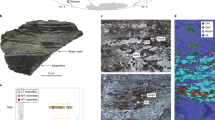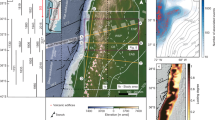Abstract
Seismic anisotropy in the oceanic lithosphere results from flow-induced crystallographic preferred orientation of dry olivine during lithosphere creation. Recent experiments, however, showed that high water activity changes the flow mechanisms of olivine and hence the crystallographic preferred orientation, better explaining the seismic anisotropy in the mantle wedge above subduction zones. Whether changes in the crystallographic preferred orientation of olivine are unique to the effects of water has become controversial and is critical to resolve. Here we report low-stress, high-strain experiments on typical dry mantle rock at high pressures and temperatures, showing that at ∼3 GPa, pressure induces the same profound transition in olivine crystallographic preferred orientation that is produced by high water activity at lower pressure. One important consequence for global tectonics is that alignment of fast seismic waves parallel to trenches beneath subducting slabs probably reflects entrainment of sub-lithospheric mantle in the direction of subduction, rather than trench-parallel flow as interpreted at present. From the large variety of crystallographic preferred orientations in olivine in both experiments and natural rocks, we infer that in addition to the pressure-induced changes in olivine slip systems implied here, there are probably further changes in slip systems at higher pressure and temperature.
This is a preview of subscription content, access via your institution
Access options
Subscribe to this journal
Receive 12 print issues and online access
$259.00 per year
only $21.58 per issue
Buy this article
- Purchase on Springer Link
- Instant access to full article PDF
Prices may be subject to local taxes which are calculated during checkout




Similar content being viewed by others
References
Nicolas, A. & Christensen, N. I. Formation of Anisotropy in Upper Mantle Peridotites—A Review (AGU, 1987).
Ben Ismail, W. & Mainprice, D. An olivine fabric database: An overview of upper mantle fabrics and seismic anisotropy. Tectonophysics 296, 145–157 (1998).
Park, J. & Levin, V. Geophysics—Seismic anisotropy: Tracing plate dynamics in the mantle. Science 296, 485–489 (2002).
Jung, H. & Karato, S. Water-induced fabric transitions in olivine. Science 293, 1460–1463 (2001).
Jung, H. et al. Effect of water and stress on the lattice-preferred orientation of olivine. Tectonophysics 421, 1–22 (2006).
Katayama, I., Jung, H. & Karato, S. I. New type of olivine fabric from deformation experiments at modest water content and low stress. Geology 32, 1045–1048 (2004).
Mizukami, T., Wallis, S. R. & Yamamoto, J. Natural examples of olivine lattice preferred orientation patterns with a flow normal a-axis maximum. Nature 427, 432–436 (2004).
Skemer, P., Katayama, I. & Karato, S. I. Deformation fabrics of the Cima di Gagnone peridotite massif, Central Alps, Switzerland: Evidence of deformation at low temperatures in the presence of water. Contrib. Mineral. Petrol. 152, 43–51 (2006).
Jung, H. Deformation fabrics of olivine in Val Malenco peridotite found in Italy and implications for the seismic anisotropy in the upper mantle. Lithos 10.1016/j.lithos.2008.06.007 (2008, in the press).
Katayama, I., Karato, S. I. & Brandon, M. Evidence of high water content in the deep upper mantle inferred from deformation microstructures. Geology 33, 613–616 (2005).
Nakajima, J. & Hasegawa, A. Shear-wave polarization anisotropy and subduction-induced flow in the mantle wedge of northeastern Japan. Earth Planet. Sci. Lett. 225, 365–377 (2004).
Long, M. D. & van der Hilst, R. D. Upper mantle anisotropy beneath Japan from shear wave splitting. Phys. Earth Planet. Inter. 151, 206–222 (2005).
Couvy, H. et al. Shear deformation experiments of forsterite at 11 GPa–1400 ∘C in the multianvil apparatus. Eur. J. Mineral. 16, 877–889 (2004).
Raterron, P. et al. Pressure-induced slip-system transition in forsterite: Single-crystal rheological properties at mantle pressure and temperature. Am. Mineral. 92, 1436–1445 (2007).
Mainprice, D. et al. Pressure sensitivity of olivine slip systems and seismic anisotropy of Earth’s upper mantle. Nature 433, 731–733 (2005).
Karato, S. I., Jung, H., Katayama, I. & Skemer, P. Geodynamic significance of seismic anisotropy of the upper mantle: New insights from laboratory studies. Annu. Rev. Earth Planet. Sci. 36, 59–95 (2008).
Zhang, S. Q. & Karato, S. Lattice preferred orientation of olivine aggregates deformed in simple shear. Nature 375, 774–777 (1995).
Katayama, I. & Karato, S. Effect of temperature on the B- to C-type olivine fabric transition and implication for flow pattern in subduction zones. Phys. Earth Planet. Inter. 157, 33–45 (2006).
Goetze, C. The mechanisms of creep in olivine. Phil. Trans. R. Soc. Lond. A 288, 99–119 (1978).
Long, M. D. & Silver, P. G. The subduction zone flow field from seismic anisotropy: A global view. Science 319, 315–318 (2008).
Peyton, V. et al. Mantle flow at a slab edge: Seismic anisotropy in the Kamchatka region. Geophys. Res. Lett. 28, 379–382 (2001).
Russo, R. M. & Silver, P. G. Trench-parallel flow beneath the Nazca plate from seismic anisotropy. Science 263, 1105–1111 (1994).
Dobrzhinetskaya, L., Green, H. W. & Wang, S. Alpe Arami: A peridotite massif from depths of more than 300 kilometers. Science 271, 1841–1845 (1996).
Jin, D. H. Deformation Microstructures of Some Ultramafic Rocks. MS thesis, Univ. of Minnesota, 1 (1995).
Tingle, T. N., Green, H. W., Young, T. E. & Koczynski, T. A. Improvements to Griggs-type apparatus for mechanical testing at high-pressures and temperatures. Pure Appl. Geophys. 141, 523–543 (1993).
Jung, H., Green, H. W. & Dobrzhinetskaya, L. F. Intermediate-depth earthquake faulting by dehydration embrittlement with negative volume change. Nature 428, 545–549 (2004).
Paterson, M. S. The determination of hydroxyl by infrared absorption in quartz, silicate glasses and similar materials. Bull. Mineral. 105, 20–29 (1982).
Bell, D. R. et al. Hydroxide in olivine: A quantitative determination of the absolute amount and calibration of the IR spectrum. J. Geophys. Res.-Solid Earth 108, 2105 (2003).
Mainprice, D. A fortran program to calculate seismic anisotropy from the lattice preferred orientation of minerals. Comput. Geosci. 16, 385–393 (1990).
Abramson, E. H., Brown, J. M., Slutsky, L. J. & Zaug, J. The elastic constants of San Carlos olivine to 17 GPa. J. Geophys. Res.-Solid Earth 102, 12253–12263 (1997).
Acknowledgements
We thank S. Karato, Z. Liu, P. G. Silver and J. Zhang for helpful discussions, F. Forgit for providing technical assistance during the preparation of the sample assemblies and D. Mainprice for an excellent constructive review. This work was supported by the Korea Meteorological Administration Research and Development Program under Grant CATER 2008–5112 (H.J.), and partially by the BK21 at SEES, SNU. Experimental work in H.W.G.’s laboratory was supported by NSF grants EAR-0552011 and EAR-0652960.
Author information
Authors and Affiliations
Contributions
H.J. and H.W.G. conceived the idea. H.J. conducted the high-pressure experiments. H.J. and W.M. analysed the CPO of olivine using EBSD and the water content of olivine using FTIR. H.J. wrote the first draft; H.W.G. revised it extensively. All authors discussed the results and commented on the manuscript.
Corresponding authors
Supplementary information
Supplementary Information
Supplementary Information (PDF 79 kb)
Rights and permissions
About this article
Cite this article
Jung, H., Mo, W. & Green, H. Upper mantle seismic anisotropy resulting from pressure-induced slip transition in olivine. Nature Geosci 2, 73–77 (2009). https://doi.org/10.1038/ngeo389
Received:
Accepted:
Published:
Issue Date:
DOI: https://doi.org/10.1038/ngeo389
This article is cited by
-
Rheology of continental lithosphere and seismic anisotropy
Science China Earth Sciences (2024)
-
Large-scale variation in seismic anisotropy in the crust and upper mantle beneath Anatolia, Turkey
Communications Earth & Environment (2021)
-
Deep earthquakes in subducting slabs hosted in highly anisotropic rock fabric
Nature Geoscience (2018)
-
Deformation history of Pinatubo peridotite xenoliths: constraints from microstructural observation and determination of olivine slip systems
Physics and Chemistry of Minerals (2017)
-
Crystal preferred orientations of olivine, orthopyroxene, serpentine, chlorite, and amphibole, and implications for seismic anisotropy in subduction zones: a review
Geosciences Journal (2017)



